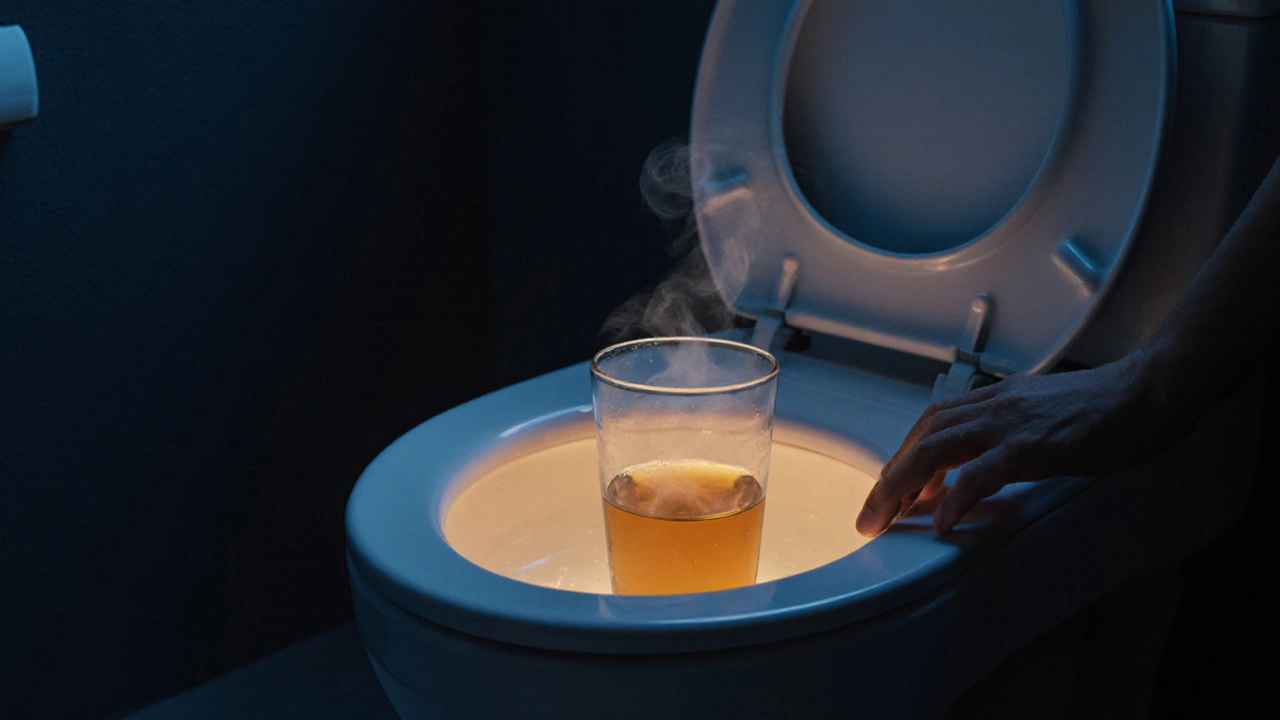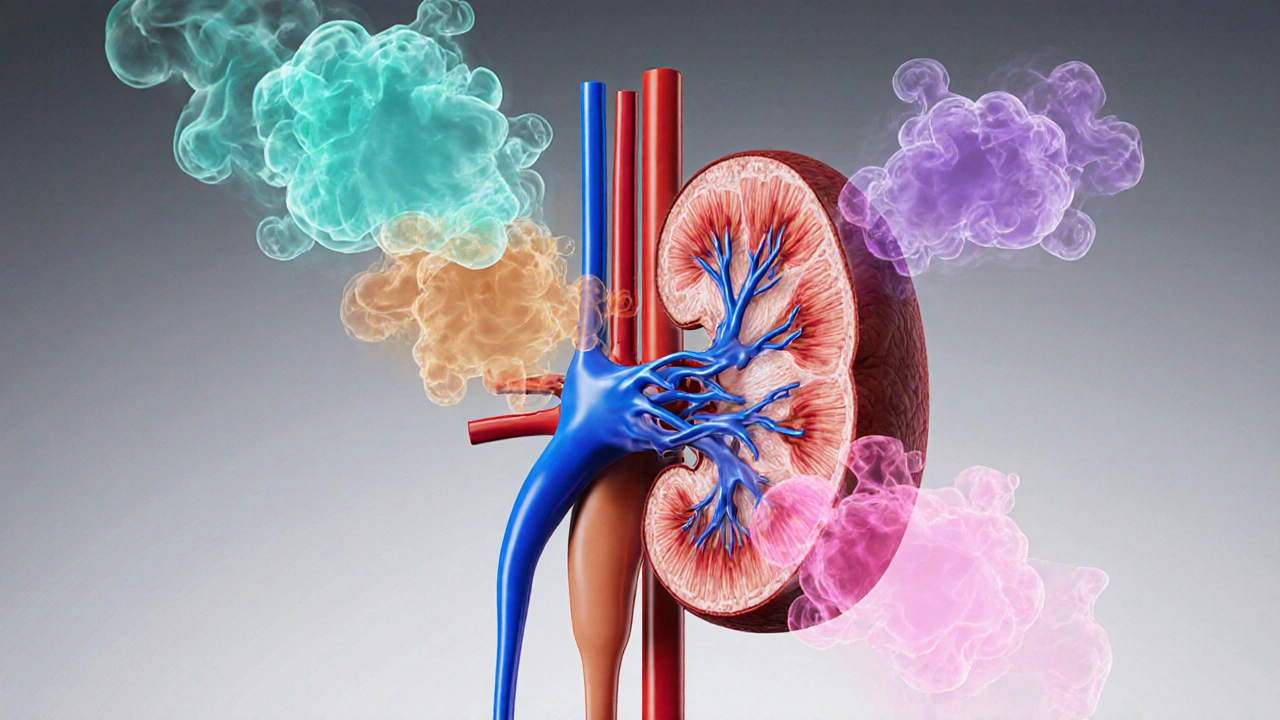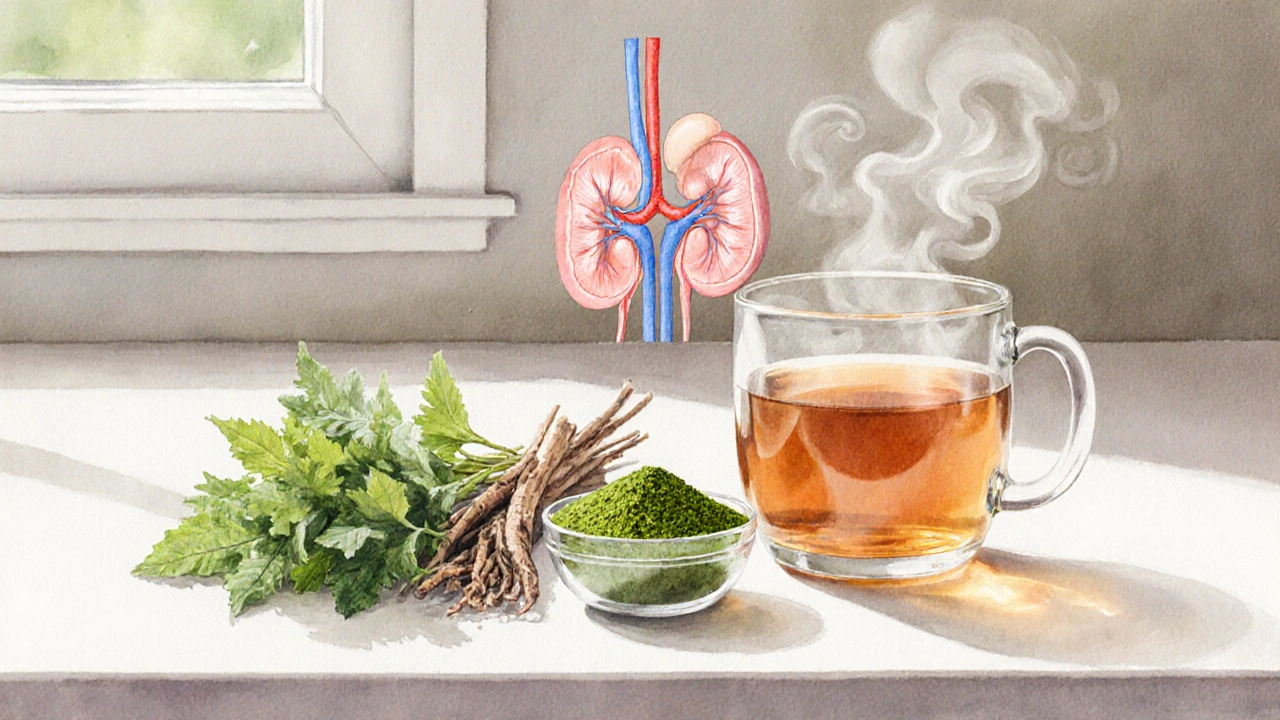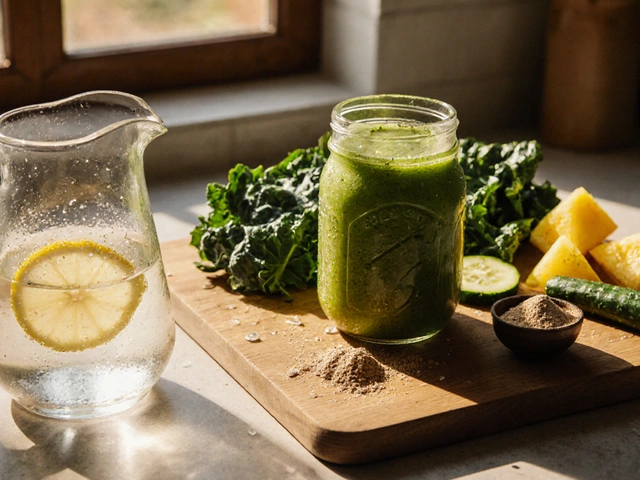
Urine Odor Assessment Tool
Identify Odor Characteristics
Select all odors you're experiencing. This tool provides general information based on kidney health research.
Additional Symptoms
Select any other symptoms you're experiencing.
Important Notes
Assessment Results
When you notice a strange scent coming from the bathroom, it’s easy to brush it off as just a bad day for the plumbing. But if the smell lingers and the color of the urine shifts, it could be a signal from your body. Kidney failure often changes the way urine smells, and understanding those cues can help you act before the problem worsens.
Why urine odor matters
Urine is mostly water, but it also carries waste products the kidneys filter out of the blood. When the kidneys work properly, most of the foul‑smelling compounds are eliminated in the stool or broken down by the liver. When filtration drops, those compounds stay in the bloodstream and eventually spill into the urine, changing both its color and its scent.
Key chemicals that shape urine odor
Several volatile compounds are responsible for the smells we associate with urine. Below are the most common culprits and how they behave when kidney function declines.
- Uremia is a buildup of nitrogenous waste in the blood that occurs when kidneys can’t filter properly. It often gives urine a bitter, ammonia‑like odor.
- Ammonia is a nitrogen compound produced from protein breakdown; normally converted to urea and excreted safely. In renal impairment, excess ammonia can escape into the urine, creating a pungent, “cat‑pee” smell.
- Cresol is a phenolic compound linked to bacterial metabolism in the gut; elevated levels result in a sweet, tar‑like odor. \n
- Acetone is a ketone body that rises during prolonged fasting or uncontrolled diabetes. When kidneys are struggling, acetone can appear in urine, giving it a fruity or nail‑polish‑remover scent.
How kidney failure transforms each smell
In early‑stage chronic kidney disease (CKD), the odor may be faint or intermittent. As glomerular filtration rate (GFR) drops below 30 ml/min, the concentration of waste compounds spikes, and the smell becomes unmistakable.
- Ammonia‑rich urine: A sharp, almost metallic scent that can remind you of cleaning products. This typically appears when blood urea nitrogen (BUN) climbs above 30 mg/dL.
- Cresol‑laden urine: A sweet, slightly medicinal aroma, often reported by patients with GFR under 20 ml/min.
- Acetone‑tinged urine: A faint fruity note, more common in kidney patients who also have poor glucose control.
These odors are not just unpleasant-they signal that toxins are accumulating faster than the kidneys can clear them.

What the smell tells you about disease progression
Medical professionals use urine odor as a quick, non‑lab clue. While it’s never a definitive diagnosis, a sudden change can indicate:
- Acute kidney injury (AKI) after dehydration or medication toxicity.
- Advancement from stage 3 to stage 4 CKD.
- Onset of uremic syndrome, which may require dialysis.
If you notice a persistent, strong odor that doesn’t improve with hydration, it’s wise to schedule blood work (creatinine, BUN, eGFR) and discuss the findings with a nephrologist.
Herbal detox options that support kidney health
While herbs can’t reverse severe renal failure, certain botanical agents may help reduce toxin load in milder cases or support overall kidney function. Below are three herbs that have shown promise in small clinical studies.
- Nettle (Urtica dioica) is a diuretic herb that encourages fluid excretion and may lower BUN levels. A typical dose is 300 mg of dried leaf extract twice daily.
- Dandelion Root (Taraxacum officinale) is rich in potassium and antioxidants; it promotes gentle diuresis without over‑taxing the kidneys. Steep 1‑2 teaspoons of dried root in hot water for a daily tea.
- Chlorella is a green algae known for binding heavy metals and reducing oxidative stress. 2 grams of powdered chlorella per day can aid in toxin clearance.
Before adding any herb, especially if you’re on prescription meds like ACE inhibitors or diuretics, consult a healthcare provider to avoid interactions.

Practical steps you can take right now
- Increase water intake to at least 2 liters per day, unless your doctor has restricted fluids.
- Track urine color and odor in a simple log; look for trends over a week.
- Limit high‑protein meals temporarily; excess protein raises urea production.
- Reduce sodium and processed foods that add extra waste products to the bloodstream.
- Incorporate the herbal options above only after medical clearance.
When to seek medical attention
Changes in urine smell alone aren’t an emergency, but they become urgent if accompanied by any of the following:
- Swelling in ankles or face (edema).
- Persistent fatigue, nausea, or loss of appetite.
- Shortness of breath or chest discomfort.
- Blood in the urine or a dramatic darkening of color.
These symptoms suggest that waste accumulation is affecting other organs, and prompt evaluation can prevent the need for dialysis.
Frequently Asked Questions
Why does my urine smell like ammonia when my kidneys are failing?
Ammonia builds up as the body breaks down protein. Healthy kidneys convert most of it into urea, which is less volatile. When kidney function drops, ammonia isn’t fully processed and leaks into the urine, creating that sharp, cleaning‑product smell.
Can herbal detox cleanses reverse kidney failure?
Herbs like nettle, dandelion root, and chlorella can aid mild toxin reduction and support healthy urine flow, but they can’t cure advanced renal failure. They should be used only as complementary measures alongside medical treatment.
Is a fruity or sweet urine odor always a sign of diabetes?
A sweet, acetone‑like scent often points to ketones, which are common in uncontrolled diabetes or prolonged fasting. In kidney disease, the same odor can appear because the kidneys can’t clear ketones efficiently, so blood sugar monitoring is essential.
How much water is safe to drink if I have chronic kidney disease?
Most nephrologists recommend 1.5‑2 liters per day for early‑stage CKD, but fluid restrictions become stricter (often < 1 liter) in advanced stages or when on dialysis. Always follow your doctor’s personalized plan.
What lab tests confirm the cause of a strong urine odor?
Key tests include serum creatinine, BUN, eGFR for kidney function; urine dipstick for ketones, blood, and protein; and a metabolic panel to check electrolyte balance. Elevated BUN and low eGFR together with a high urine ammonia level strongly suggest renal involvement.









9 Comments
Oh great, another “fun” way to tell your kidneys are on strike – just sniff your toilet water, because who doesn’t love a good ammonia perfume, right?
From a strictly physiological perspective, the accumulation of nitrogenous waste products such as urea and creatinine is directly proportional to the decline in glomerular filtration rate. The literature consistently demonstrates that elevated blood urea nitrogen (BUN) correlates with the characteristic ammoniacal odor described in the article. Moreover, the presence of cresol and phenolic compounds is not merely anecdotal; they have been quantified in several peer‑reviewed studies involving stage‑3 and stage‑4 chronic kidney disease patients. It is also worth noting that environmental factors, including contaminated water sources, can confound odor perception, a variable that many clinicians overlook. Therefore, while urine smell can serve as an adjunctive clue, it should never replace laboratory diagnostics.
Tracking changes in urine odor can actually be a simple yet powerful self‑monitoring tool-think of it as a quick “check‑in” with your own body. By noting the scent and color each day, you create a personal baseline that makes any deviation stand out more clearly. This habit, combined with regular hydration, can help catch a decline before symptoms become severe. Remember, you’re not alone in this; many patients find that a small logbook empowers them to act early and stay ahead of complications.
Exactly, the logbook approach isn’t just cute-it’s clinically relevant. When you can point to a pattern of escalating ammonia or cresol smells, your nephrologist can interpret that data alongside labs to adjust treatment promptly. Don’t be afraid to share your observations; the more objective information you provide, the more aggressive the care can be, potentially slowing progression.
Adding to that, it’s also helpful to couple scent tracking with dietary tweaks, like reducing excess protein and sodium, which directly lessen urea production. Small changes in meals can translate into noticeable differences in odor and, more importantly, in overall kidney workload.
While the biochemical pathways are sound, let's not ignore that many patients report subjective odors that don't always match lab values-perhaps due to gut microbiome variations or even kitchen cleaners influencing perception. This discrepancy can be a fertile ground for further research, if you ask me.
When you start paying attention to the subtle shifts in urine odor, you’re essentially turning your body into a real‑time laboratory, a concept that has fascinated physicians for decades.
The renal system, much like a diligent custodian, filters out waste, and when its efficiency wanes, the by‑products that would normally be hidden in the stool or metabolized by the liver begin to surface in the urine.
One of the first compounds you might notice is ammonia, which gives that sharp, cleaning‑product smell that can be oddly alarming to anyone who’s never experienced it.
If you’ve ever been in a situation where you’re drinking plenty of water yet still catching a whiff of that pungent scent, it’s a sign that the blood urea nitrogen (BUN) is climbing, often above the 30 mg/dL threshold mentioned in clinical guidelines.
Cresol, on the other hand, carries a sweet, tar‑like aroma that is less common but indicative of even more advanced renal impairment, typically when glomerular filtration rate (GFR) drops below 20 ml/min.
Acetone’s fruity odor, reminiscent of nail‑polish remover, isn’t exclusive to diabetics; in renal patients it emerges because the kidneys can’t clear ketone bodies efficiently, especially when there’s concurrent poor glucose control.
These odors aren’t just random; they are chemical signatures that reflect the underlying metabolic chaos caused by failing nephrons.
By documenting the presence, intensity, and duration of each scent, patients can create a timeline that aligns with lab results, making it easier for clinicians to pinpoint the exact stage of disease progression.
For instance, a sudden shift from a faint ammonia hint to a dominant cresol scent over a few days might signal a rapid decline from stage 3 to stage 4 chronic kidney disease, prompting an urgent reassessment of medication dosages and fluid management.
Additionally, such observations can guide dietary modifications-cutting back on high‑protein meals reduces urea generation, while increasing alkalizing foods can help neutralize some of the acidic by‑products that contribute to odor.
Herbal adjuncts like nettle, dandelion root, and chlorella, when used responsibly under medical supervision, may assist in managing mild toxin loads, but they are not a substitute for evidence‑based therapies such as ACE inhibitors or dialysis when indicated.
It’s also worth noting that environmental factors, such as the use of strong household cleaners or certain antibiotics, can temporarily alter urine smell, so keeping a log can help differentiate medication effects from true renal decline.
In practice, many nephrologists appreciate a concise odor chart because it provides a quick visual cue during appointments, especially when lab turnaround times are delayed.
Ultimately, while odor alone will never replace serum creatinine or eGFR measurements, it serves as an inexpensive, non‑invasive, and immediate red flag that can accelerate clinical decision‑making and potentially improve outcomes.
So next time you catch that “cat‑pee” whiff, don’t just wave it off-take a note, hydrate, and consider reaching out to your healthcare team before the situation escalates.
Sure, the “odor log” sounds poetic, but let’s be realistic: human noses are notoriously inconsistent, and the ambient smell of cleaning products or diet can masquerade as renal markers. Relying on a subjective scent as a diagnostic cue is a slippery slope that could lead to unnecessary panic or, worse, delayed proper testing.
One must question the very epistemology of equating olfactory cues with renal pathology; such reductionist approaches betray a complacent adherence to anecdotal heuristics, neglecting the nuanced interplay of systemic homeostasis that resists simplification.